NanoCoatings has assembled wear-testing and characterization capabilities and has access to additional equipment at South Dakota School of Mines and Technology (SDSM&T), as described below.
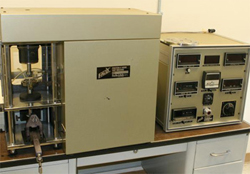
Faville LeVally Multispecimen Tester for evaluating the friction and wear characteristics of substrate materials, coatings, and lubricants. Capability to vary the contact geometries, motion, speed, temperature and contact pressure to enable simulation of industrial sliding applications.
Faville LeVally Block-on-Ring (BOR) tester for conducting 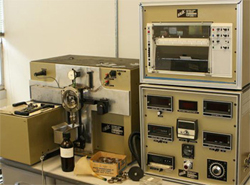 friction / wear tests under dry-unlubricated or lubricated (grease, oil, water) conditions. Coatings as well as bulk materials (metals, composites, etc.) can be tested. Data output includes continuous recording of a load-cell voltage output which is converted to a resisting frictional force and eventually to a coefficient of friction (COF). Graphical representation of COF vs. time, rotational cycles, or total distance slid is reported. Wear surfaces are photographed and standard wear-factors for the tested materials are reported.
friction / wear tests under dry-unlubricated or lubricated (grease, oil, water) conditions. Coatings as well as bulk materials (metals, composites, etc.) can be tested. Data output includes continuous recording of a load-cell voltage output which is converted to a resisting frictional force and eventually to a coefficient of friction (COF). Graphical representation of COF vs. time, rotational cycles, or total distance slid is reported. Wear surfaces are photographed and standard wear-factors for the tested materials are reported.
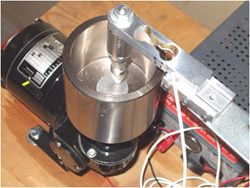 |
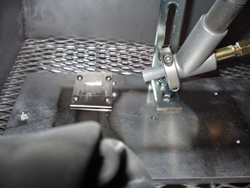 |
| Pin (or ball)-on-disk wear test machine for basic surface properties, such as scratch-adhesion and coefficient of friction of coatings and substrates. | Sand-erosion test fixture to enable the erosion testing of coatings and materials under different incidence angles. |
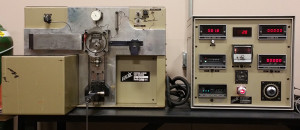 |
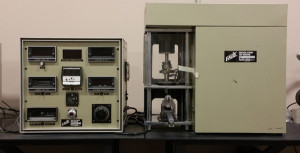 |
| Falex Block-on-Ring Wear Tester | Falex Multispecimen Wear Tester |
We also have access to other test and characterization equipment located at SDSM&T, which includes:
1) Rockwell Hardness Tester used to measure hardness of materials and apply indents to evaluate the adhesion and interfacial toughness of coatings;
2) Nanoindenter to measure coating hardness and elastic modulus;
3) Rubber-Wheel Sand Abrasion Tester to measure sand-abrasion following ASTM G65;
4) Scanning Electron Microscope (SEM) with Energy Dispersive Spectroscopy (EDS) for high-magnification imaging and composition analysis;
5) X-ray Diffraction (XRD) for coating structure and phase identification; and
6) Potentiodynamic Polarization Corrosion test cells and associated equipment to measure basic corrosion potential and corrosion current density of materials and coatings.
